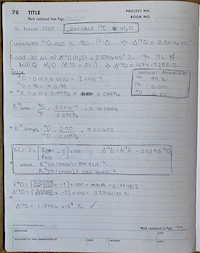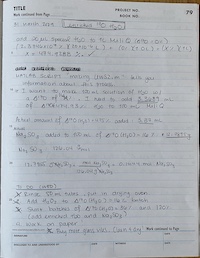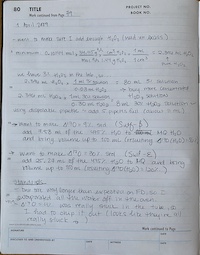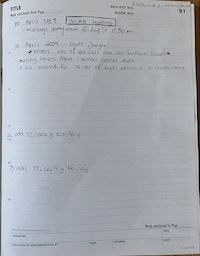Sulfate Oxygen Standards - 2009
In 2009 Helen Amos created our first round of sulfate oxygen isotope standards, named sulf-α, sulf-β, and sulf-ε by equilibrating sodium sulfite with 17O enriched water followed by conversion to sulfate with hydrogen peroxide.Sulfate reference materials with Δ17O values comparable to atmospheric-ozone-influenced sulfate do not exist. We wanted to create a suite of 17-O enriched sulfate reference materials with Δ17O values >0 and <50 ‰. An undergraduate student at the time, Helen Amos, under the direction of Becky Alexander, created these reference materials for calibration of our sulfate oxygen isotope research program.
We are running low on these reference materials. So, the purpose of this post is the create a digital record of Helen's efforts 12 years ago, make certain we understand them, and prepare to create another round of sulfate oxygen isotope reference materials.
The original recipe
This recipe was published in our 2012 oxygen isotope exchange paper (Schauer et al. 2012). The very first time these standards were measured, however, the results came back looking as if the recipe was flawed because all of the Δ17O values were near zero. After this observation, Helen rewrites in her notebook (not shown in photos above) the calculations leading up to the recipe to verify they were correct. At this point Helen's efforts shifted away from these standards and she passed the stick to Eric Sofen, graduate student with Becky at the time.
In recent email exchanges with Helen and Eric, it was discovered that the Ion Chromatograph (IC, and affectionately named Yertle) had a leak across the ion exchange membrane. After repairing Yertle, subsequent measurements of this batch of sulf-α, sulf-β, and sulf-ε standards provided the dataset for our publication.
Note the publication states 20 mL of 90% 17O water was added to 1 L of 18 Mohm water. Helen's notes indicate 20 µL of 90% 17O water was added to 1 L of 18 MΩ water. Looking back at the versions of the manuscript leading up to submission also show 20 µL and the micro character shifts to an unrecognized character and then to an 'm'. This error was not caught in the proofs. This won't matter for the second generation of the sulfate standards because Becky found the 1 L bottle of 17-O labeled water with a Δ17O = ~474 ‰.
The recipe, then, to repeat Helen's notes and quote the Schauer et al. 2012 paper (with the micro vs milli error fixed):
"A volume of 20 µL of 90% 17O water (Cambridge Isotope Laboratories, Andover, MA, USA) was added to 1 L of 18 MΩ water (locally produced from tap water, Seattle, WA, USA) to make the 17O-labeled water. Volumes of 3.5 mL, 7.5 mL, and 25 mL of the labeled water were added to 12.5 g of Na2SO3 to make in-house standards, Sulf-a, Sulf-b, and Sulf-e, respectively, along with enough 18 MΩ water to bring the total volume of each to 100 mL. The Na2SO3 and labeled water were allowed to equilibrate for approximately 12 h. A volume of 10 mL of 30% H2O2 was then added to each solution to convert the Na2SO3 into Na2SO4. Water was removed from the solution by evaporation in a 60 °C drying oven."
Accepted values
The accepted values for sulf-α, sulf-β, and sulf-ε can be found on our reference materials page as well as in the Schauer et al. 2012 paper. As described in the paper, the accepted values were declared after measurement using gold capsules. The quartz capsule measurement gives a depressed Δ17O value due to oxygen exchange between the mass dependent quartz and the mass independent sulfate standards.
The original target was to obtain sulfate standards with Δ17O values spanning a range from >0 to <50 ‰. Our initial estimate of 17-O propagation from 17-O labeled water to sodium sulfite and then to sodium sulfate was high. The result of the above recipe gave a range in Δ17O values from 0.9 to 7.0 ‰. This range is still sufficient to capture our observed natural variation in atmospherically influenced sulfate.
References
- Schauer AJ, Kunasek SA, Sofen ED, Erbland J, Savarino J, Johnson BW, Amos HM, Shaheen R, Abaunza M, Jackson TL, Thiemens MH, Alexander B. (2012). Oxygen isotope exchange with quartz during pyrolysis of silver sulfate and silver nitrate. Rapid Communications in Mass Spectrometry 26. doi: 10.1002/rcm.6332.




